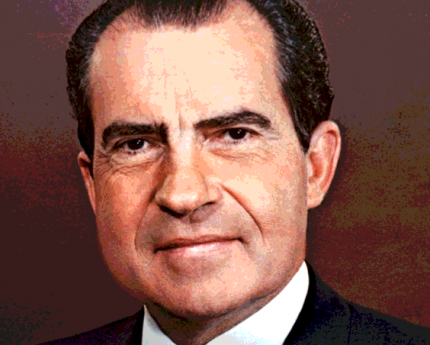
As background: On June 17, 1972, burglars were caught in the Democratic National Committee's offices in the Watergate office complex. Five men were arrested.
Even so, that November, Nixon was re-elected in a landslide victory. But in the months that followed, top-level presidential appointees were implicated in the scandal. By May 1973, the U.S. Senate Watergate Committee (formally, the Select Committee on Presidential Campaign Activities) began to meet. The existence of an “enemies list” was one of the explosive stories to come from those committee hearings.
Eventually, Nixon was forced out of office. Facing the prospect of impeachment, he resigned Aug. 8, 1974. Here is the rundown on the enemies list, along with a list of resources:
How the public learned about the enemies list: John Dean, former White House counsel, disclosed the existence of an enemies list during his testimony before the Senate Watergate Committee.
During questioning, Sen. Lowell P. Weiker, R-Conn., was “particularly incensed about the administration’s political abuse of government agencies like the FBI and the IRS,” Dean later wrote the book, Blind Ambition: The White House Years (Open Road Media).
Dean explained that he possessed “a memorandum that was requested of me, to prepare a means to attack the enemies of the White House. There was also maintained what was called an ‘enemies list,’ which was rather extensive and continually being updated.”
Sitting up straight, Weicker quipped, “I am not going to ask who was on it. I’m afraid you might answer.”
Some examples includes "grant availability, federal contracts, litigation, prosecution."
During his testimony, Dean said that Nixon discussed "the use of the Internal Revenue Service to attack our enemies."
Later that year, on Dec. 21, 1973, The New York Times reported that Dean "turned over a second list of 575 White House 'enemies' to the Internal Revenue Service in September, 1972, with a request that the IRS 'see what type of information could be developed' about those named."
Why did Dean write the memo? In an NPR interview in 2015, Dean said he wrote a memo because he was told to. The enemies list was compiled by another aide, Charles Colson, and included actors, politicians, journalists and activists, such as:
- Arnold M. Picker of United Artists.
- Edward Guthman, national editor of the Los Angeles Times.
- Morton Halperin, former aide to Henry Kissinger.
- Broadway star Carol Channing.
- CBS reporter Daniel Schorr.
- Newspaper columnist Mary McGrory.
- Rep. John Conyers, D-Mich.
- Actor Paul Newman.
What happened to those on the list? Nothing, according to Dean. In the 2015 NPR interview, Dean said, “You cannot name anybody based on that program who was ever the subject of any attack… In other words, the federal machinery was never used to screw them. It got tremendous press play, but it got overplayed.”
What was the significance for Nixon? The Committee on the Judiciary of the U.S. House of Representatives approved articles of impeachment against Nixon in July 27, 1974. Abuse of power was part of the rationale. Article II of Nixon's impeachment said the president's conduct had "included one or more of the following: He has, acting personally and through his subordinates and agents, endeavored to obtain from the Internal Revenue Service, in violation of the constitutional rights of citizens, confidential information contained in income tax returns for purposes not authorized by law, and to cause, in violation of the constitutional rights of citizens, income tax audits or other income tax investigations to be initiated or conducted in a discriminatory manner.”Nixon announced his resignation less than two weeks later, on Aug. 8, 1974.
Resources:
- Blind Ambition: The White House Years, By John W. Dean (Open Road Media).
- Connecticut Public Radio: John Dean says Nixon's enemies list was never used to 'screw' anyone.
- Hood College digital collection: The Washington Post, White House maintained list of political enemies, '71-'72, By Bob Woodward and Carl Berstein, June 28, 1973.
- The American Presidency Project at the University of California, Santa Barbara: Articles of Impeachment Adopted by the House of Representatives Committee on the Judiciary, July 27, 1974.
- The New York Times: Congressional unit says Dean gave IRS second enemies list.
Related:
How presidents respond to hatred
If you wish to comment, like us on Facebook and tell us what you think.